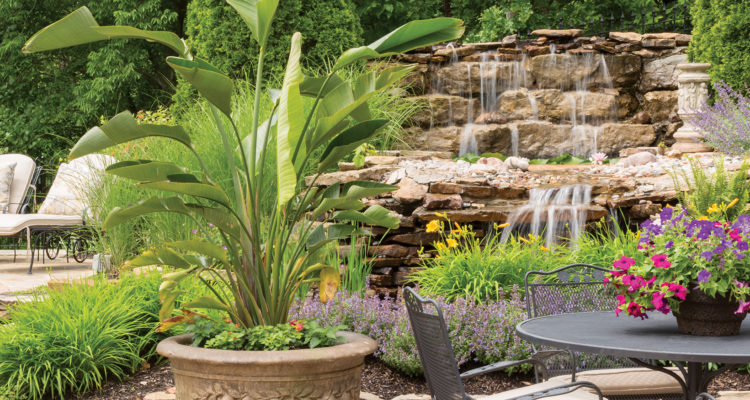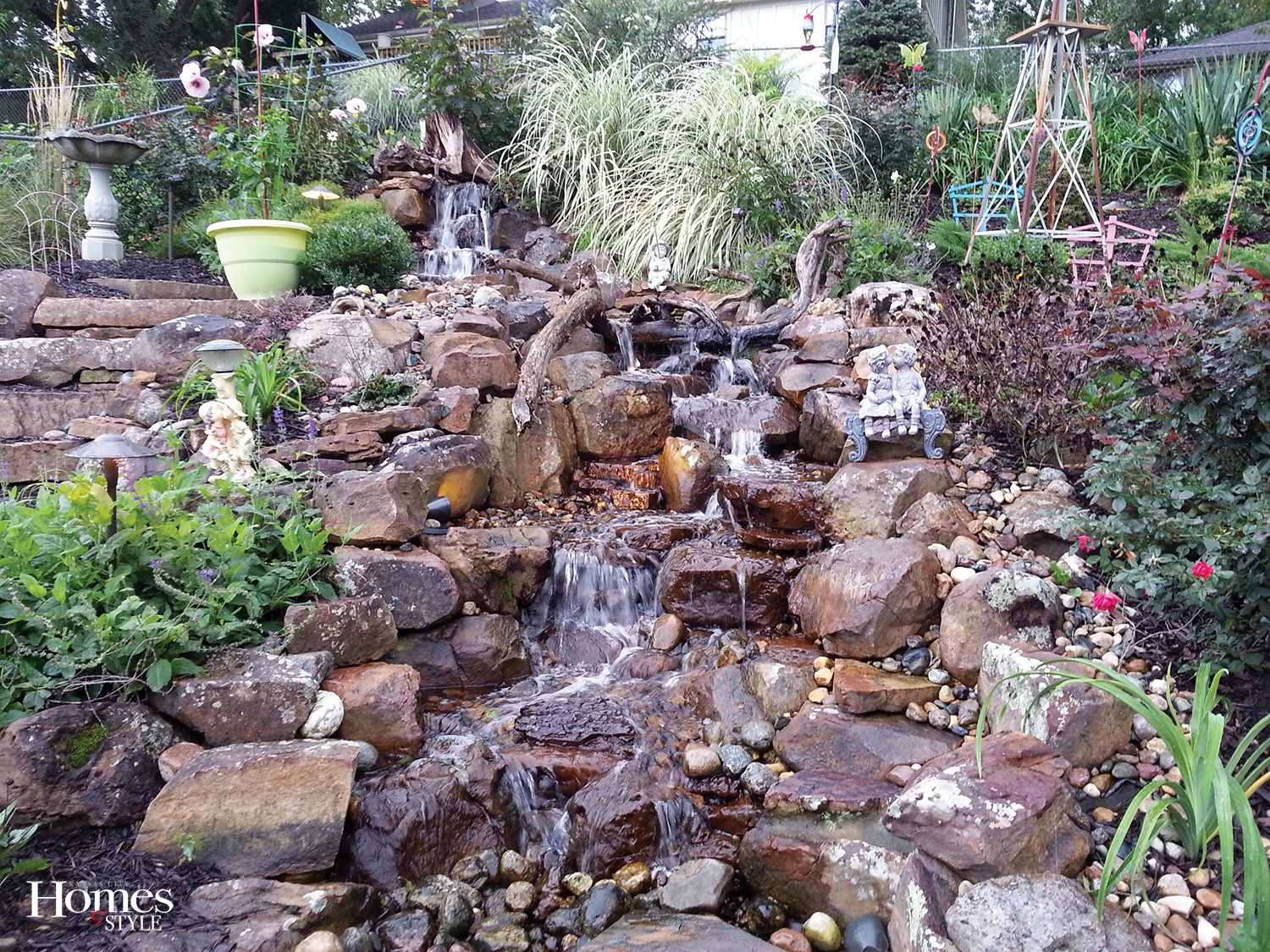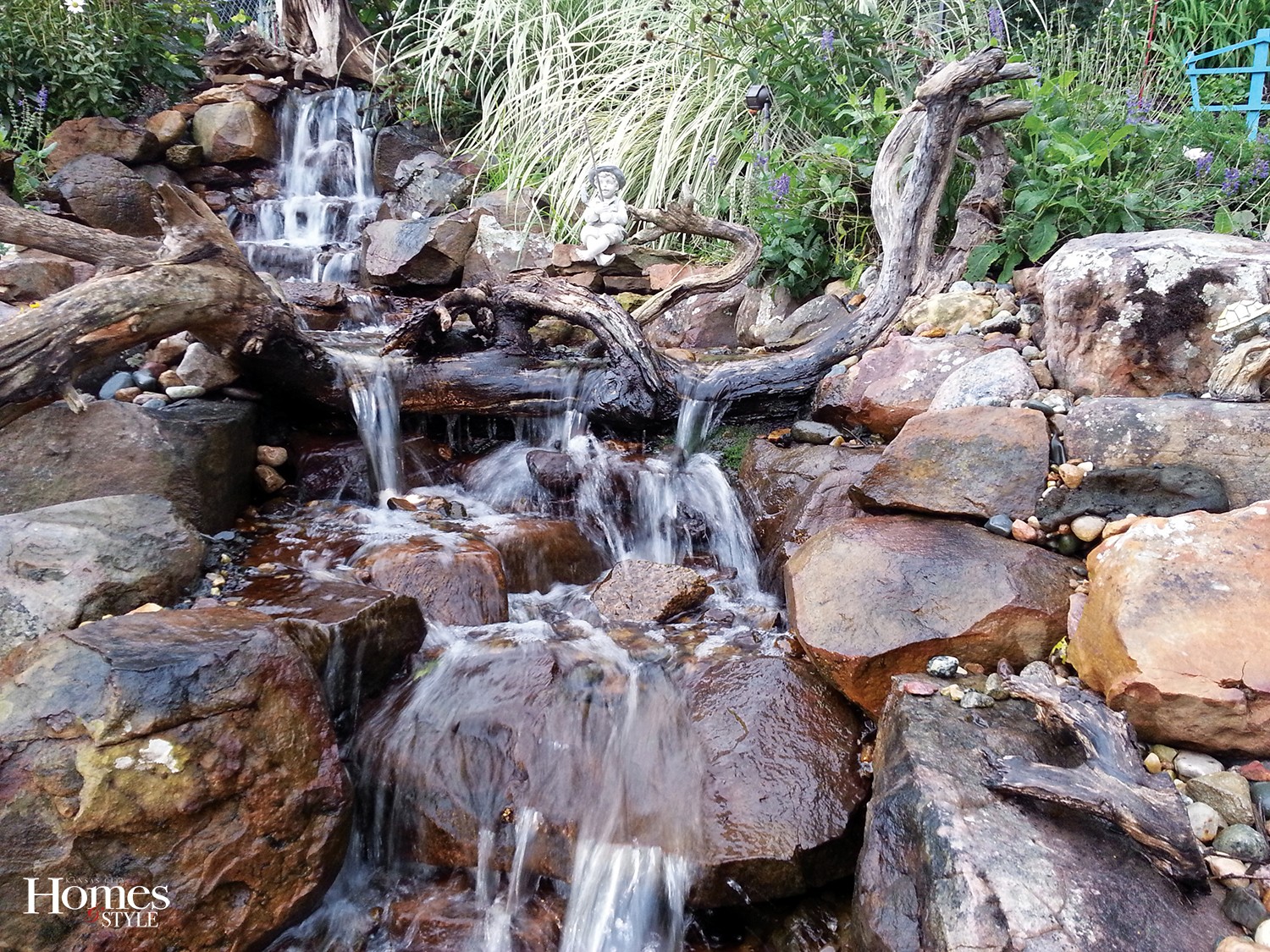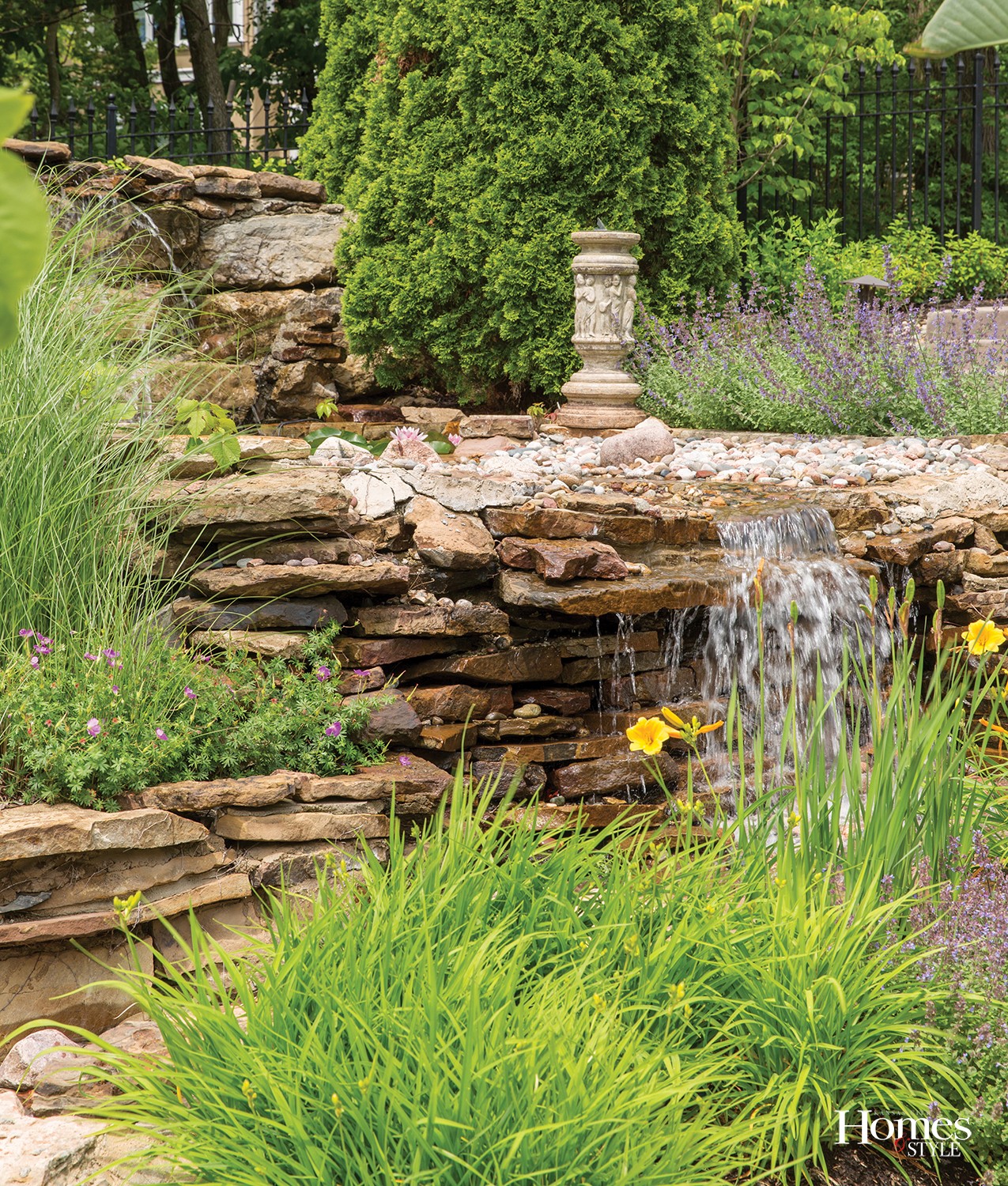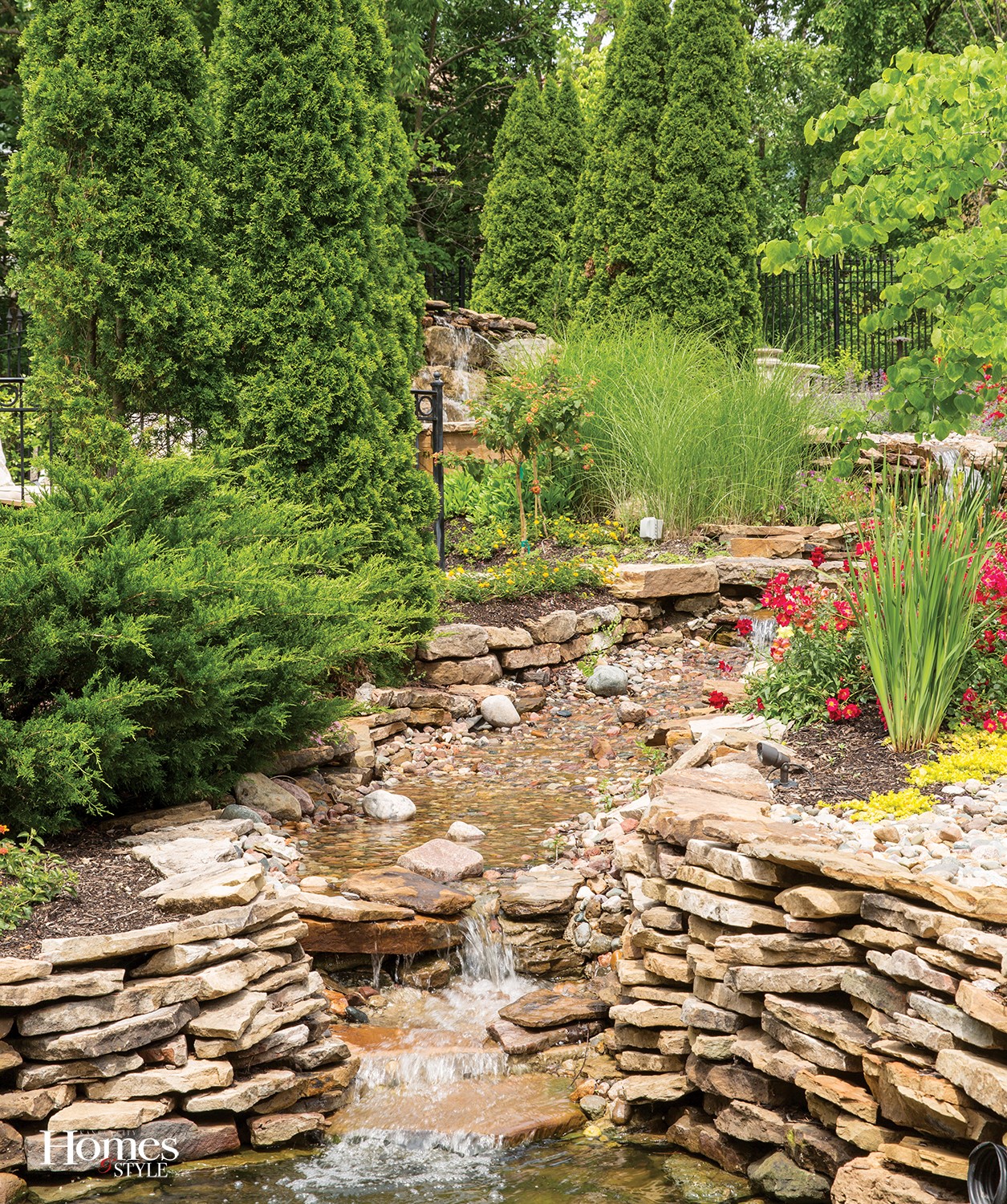Story by Ann Butenas
There is something inherently soothing about the sound of water, especially when it comes in the form of a babbling brook, cascading waterfall, a mounted wall feature or even a bubbling rock or statuary. It’s a wonderful embrace of the senses, both visual and auditory. If you have ever considered incorporating any type of water features into your residential landscaping, you could be in store for a little slice of heaven on earth, adding a sense of exploration to your outdoor space. We visited three backyards, all of various sizes and terrains, and found that regardless of the size and shape of your yard, you too can have a backyard haven that serves are a getaway for not just you but wildlife too.
When this particular homeowner wanted to turn a challenging steep lawn into more of a pleasurable outdoor setting (that also didn’t require pushing a lawn mower up and down the grade!), he turned to the experts at Good Earth Water Gardens, experts in water features and landscaping.
Based in Parkville, Missouri, owner Dan Stanza was happy to accommodate his client. A specialist in water features, Stanza understands the draw to water as a wonderful element to include in any landscape feature. And as a Pro Certified Aquascape Contractor, Stanza had a few ideas in mind and the end result took this difficult to navigate terrain and turned it into a hillside wonder.
“We had already done some work for him by slowly eliminating the grass on this particular hillside. He originally thought he wanted a patio and a small waterfall but remained open to any ideas we brought to the table.”
As such, Stanza and his crew created a perfectly flowing waterfall and brought it all the way down the hill, creating an eye-catching 30-foot long escalade of soothing tranquility, which disappears into a reservoir at the bottom and then recirculates back up to the top.
Even in the winter months, the homeowner can enjoy this natural masterpiece, as the entire ensemble is practically maintenance-free.
“In the colder months, you don’t turn off the water; you just make sure you fill up the reservoir a few times,” explained Stanza. “The water will naturally freeze on top but it still run underneath. In reality, all the homeowner has to do is just enjoy it.”
The accompanying rocks add a grand gesture of rugged good looks to the scene and are a collective of native weathered field stone, also referred to as moss rock.
“All of the rocks were actually brought in by hand or ball cart and individually laid onto the site,” noted Stanza.
Now in his eighth season of business, Stanza specializes in water features and clearly enjoys sharing his expertise and working with clients on a variety of projects, no matter the scope or size.
“We can help someone with something as simple as a fountainscape or a small pond-less waterfall to just going all out with a bigger pond and a variety of landscape elements,” said Stanza. It’s creating the atmosphere that the homeowner wants and the yard allows.
Project Designer: Good Earth Water Gardens
From atop the hill, this babbling waterfall cascades past lush evergreens and brightly colored flowering plants pooling into a small patio-side pond, adding just the right touch to this Leawood backyard. The homeowners desired an inviting entertainment space that incorporated the natural environment of their backyard and turned to Rosehill Gardens to create just that.
Gary Lueckenotto, landscape designer with Rosehill Gardens, understands that people gravitate towards the element of water in their landscaping plans for a variety of reasons.
“Of course, there is the aesthetics of your feature and people do enjoy the sound,” he explained. “It’s also a great way to incorporate a wildlife habitat, perfect for birds and even for butterflies that can tap into the edges of the water if it is shallow enough.”
When designing an outdoor water feature with a stream leading to a catch basin or pond area, the type of plant life used is extremely important. The plants most conducive to this environment include lotus, water lilies (hardy and tropical varieties), water hyacinths, and papyrus plants, to name a few. However, tropical plants do need to be brought inside in the winter months.
The best stones to use to maintain proper pH balances in water features include the rounded granite ones, decorative river rock and native limestone, which is indigenous to this area. However, some caution should be applied when using the latter.
“The limestone can make the water fairly alkaline,” explained Lueckenotto, adding that sandstone or quartz can also be used, as they allow the water to easily flow over them while not creating a highly alkaline environment.
In order to keep the water flowing, many people opt to install a smaller pond at the top of the waterfall in the form of a pre-fabricated unit that can fill up with water and spill out, flowing down the embankment to the larger basin below. This type of waterfall feature is perfect for managing a slope in the yard, changing a hillside problem to a delightful pleasure.
As far as maintenance goes, it does take a bit of planning and work to keep these water features at optimum health. It is important to clean out the lower pond to deter algae build-up. Netting can be placed over the larger pond to reduce leaf accumulation. In the winter, it is best to have a lower pond that is large enough where it does not freeze solid, as freezing displaces the water volume within the unit.
Other options for the lower pond include stocking it with koi fish, a year-round and fun addition.
“The fish will need proper plant life in the lower pond for oxygen, especially as they go dormant in the winter months,” noted Lueckenotto. “Additionally, you have to monitor water levels in the lower basin so the pump does not run dry. However, when temperatures drop below freezing, you do get some interesting icicles and water formations.”
Project Designer: Rosehill Gardens
When you step into this gorgeous Leawood residential setting, you immediately see that there is something for everyone to enjoy. From the back door and onto the deck, the 8,000-gallon koi pond stocked with 27 koi fish is within arm’s reach. Go down a few steps and you are suddenly at pool level. A six-foot wide waterfall takes off from where the pond goes down, situated as if it is coming right out of the deck. A host of low maintenance perennials decorate the surrounding areas. Rocks of various sizes and shapes add to the vacation-like setting. Literally every square inch of this slice of heaven-on-earth is dedicated to a welcoming feeling of tranquility and escape, with not a blade of grass to be seen in the space.
Born from a hobby of turning their own backyard into a natural wonderland, Wendy Hix and her son and partner Tate Foster, of Hix and Son Aquatics. now get to spend their days playing in other people’s yards, bringing their exciting ideas and designs to life, especially when it comes to water features.
“Our main emphasis is on water features and aquatic plants,” expressed Wendy, who partners with other landscape designers when it comes to trees and shrubbery.
Although koi ponds are fun to have, Wendy indicated they do require a bit more maintenance than a water feature alone, including at least a 200-pound supply of koi food for the season (for large koi) and fruits such as watermelon, oranges and grapefruit, as well as proper installation of bottom drains and jets, which allow the pond to act like a pool and simultaneously maintain itself. The koi become dormant all winter and do not need to be fed. Once the water temperature is consistently above 55 degrees you can start feeding them again.
For those interested in a backyard koi pond, Wendy explained that the minimum size should be at least 3,500 gallons, along with a good filter system.
“Because there are no plants in a dedicated koi pond, you will need an Ultraviolet light system to help fight the algae,” she said.
Despite the fun and beauty of koi ponds, Wendy is seeing a change in that dynamic.
“We are now noticing the trend to more tranquil settings where the focus is on the sound of the water and not the maintenance,” she said, referencing disappearing water features where the water flows into a reservoir and to the plants or over a bubbling rock. Flowing water charms the ear and its glimmer catches the eye, creating a space of beauty and relaxation.

